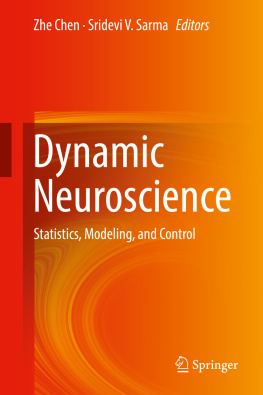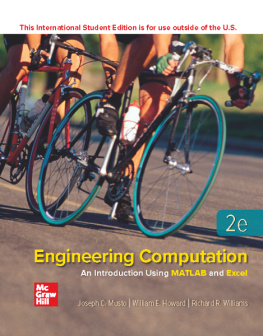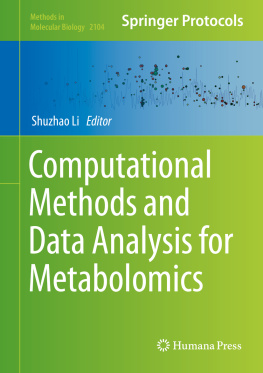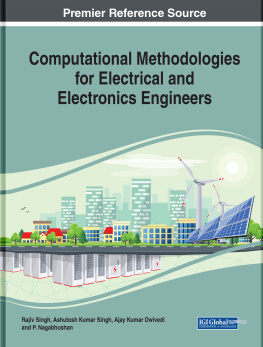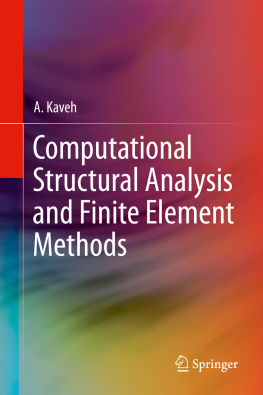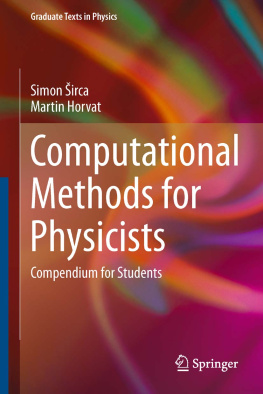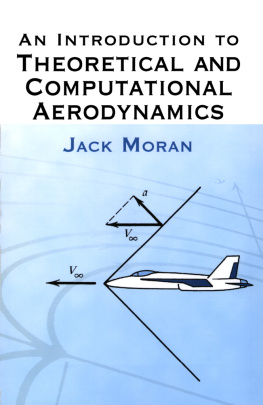Mmbaga Joseph - Computational Methods for Process Engineers
Here you can read online Mmbaga Joseph - Computational Methods for Process Engineers full text of the book (entire story) in english for free. Download pdf and epub, get meaning, cover and reviews about this ebook. year: 2021, publisher: Alpha Education Press, genre: Children. Description of the work, (preface) as well as reviews are available. Best literature library LitArk.com created for fans of good reading and offers a wide selection of genres:
Romance novel
Science fiction
Adventure
Detective
Science
History
Home and family
Prose
Art
Politics
Computer
Non-fiction
Religion
Business
Children
Humor
Choose a favorite category and find really read worthwhile books. Enjoy immersion in the world of imagination, feel the emotions of the characters or learn something new for yourself, make an fascinating discovery.

- Book:Computational Methods for Process Engineers
- Author:
- Publisher:Alpha Education Press
- Genre:
- Year:2021
- Rating:3 / 5
- Favourites:Add to favourites
- Your mark:
- 60
- 1
- 2
- 3
- 4
- 5
Computational Methods for Process Engineers: summary, description and annotation
We offer to read an annotation, description, summary or preface (depends on what the author of the book "Computational Methods for Process Engineers" wrote himself). If you haven't found the necessary information about the book — write in the comments, we will try to find it.
Computational Methods for Process Engineers — read online for free the complete book (whole text) full work
Below is the text of the book, divided by pages. System saving the place of the last page read, allows you to conveniently read the book "Computational Methods for Process Engineers" online for free, without having to search again every time where you left off. Put a bookmark, and you can go to the page where you finished reading at any time.
Font size:
Interval:
Bookmark:
Second Edition
Department of Chemical & Materials Engineering
University of Alberta
K. Nandakumar
Cain Department of Chemical Engineering
Louisiana State University
R.E. Hayes
Department of Chemical & Materials Engineering
University of Alberta
All rights reserved. No part of this book may be reproduced in any form or by any means without permission in writing from the the publisher.
This book contains information obtained from authentic and highly regarded sources. Reasonable effort has been made to publish reliable data and information, but the authors and publisher do not assume responsibility for the validity of all materials and their consequences for use. The authors and publishers have attempted to trace the copyright holders of all material reproduced in this publication and apologise to copyright owners if permission to publish in this form has not been obtained. If any copyright material has not been acknowledged, please write and let us know so we may rectify in future prints.
Trademark notice: Product of corporate names may be trademarks or registered trademarks, and are used only for identification and explanation without intent to infringe.
MATLAB is a registered product of The MathWorks, Inc. 3 Apple Hill Drive Natick, Massachusetts 01760 USA.
Published by:
ALPHA Education Press
104-2607 Ellwood Drive SW
Edmonton, AB T6X 0P7 Edmonton, AB
Library and Archives Canada Cataloguing in Publication
Title: Computational methods for process engineers / J.P. Mmbaga (Department of Chemical & Materials Engineering, University of Alberta), K. Nandakumar (Cain Department of Chemical Engineering, Louisiana State University), R.E. Hayes (Department of Chemical & Materials Engineering, University of Alberta).
Names: Mmbaga, J. P., author. Hayes, R. E. (Robert E.), author. Nandakumar, K. (Krishnaswamy), 1951- author.
Description: Second edition. Includes bibliographical references and index.
Identifiers: Canadiana (print) 20200323849 Canadiana (ebook) 20200323881 ISBN 9781989024065 (softcover) ISBN 9781989024072 (Kindle) ISBN 9781989024089 (EPUB)
Subjects: LCSH: Chemical engineering Mathematics.
Classification: LCC TP149 .M63 2020 DDC 660.01/51dc23
1.1
1.2
1.3
1.3.1
1.3.2
1.3.3
1.3.4
1.3.5
1.4
1.4.1
1.4.2
1.5
1.5.1
1.5.2
1.6
1.6.1
1.7
1.7.1
1.7.2
1.7.3
1.7.4
1.8
2.1
2.2
2.3
2.4
2.5
2.6
2.7
2.8
2.8.1
2.8.2
2.8.3
2.8.4
2.9
2.10
2.10.1
2.11
2.12
3.1
3.2
3.2.1
3.3
3.4
3.4.1
3.5
3.6
3.7
3.7.1
3.7.2
3.7.3
3.7.4
3.7.5
3.7.6
3.7.7
3.8
3.8.1
3.8.2
3.8.3
3.9
3.10
3.10.1
3.10.2
3.10.3
3.10.4
3.10.5
3.11
3.12
4.1
4.1.1
4.2
4.3
5.1
5.1.1
5.1.2
5.2
5.2.1
5.3
5.3.1
5.4
5.4.1
5.5
5.5.1
5.5.2
5.5.3
5.6
5.7
5.8
5.9
5.10
5.11
5.11.1
5.11.2
5.11.3
5.12
5.12.1
5.12.2
5.13
5.14
6.1
6.1.1
6.2
6.2.1
6.2.2
6.2.3
6.2.4
6.2.5
6.2.6
6.3
6.3.1
6.3.2
6.3.3
6.3.4
6.3.5
6.3.6
6.4
6.4.1
6.4.2
6.4.3
6.5
6.6
7.1
7.1.1
7.1.2
7.1.3
7.1.4
7.1.5
7.2
7.3
7.3.1
7.3.2
7.4
7.5
8.1
8.2
8.2.1
8.2.2
8.3
8.3.1
8.3.2
8.4
8.5
8.6
A
A.1
A.1.1
A.2
A.3
A.3.1
A.3.2
A.3.3
A.3.4
A.3.5
A.3.6
A.3.7
A.3.8
A.3.9
A.3.10
B
B.1
B.1.1
B.1.2
B.2
B.3
B.3.1
B.3.2
B.3.3
B.3.4
B.4
B.5
B.6
B.6.1
B.7
B.8
Revolutionary advances in hardware and software technology have made computer aided design and analysis a standard tool in engineering practice. While this puts a lot of power at the hands of the end user, in order to use them wisely and interpret the results correctly, the users are expected to have a sound knowledge of the relationship between the physical world and the mathematical model and that between the mathematical model and the numerical approximation.
The text is intended for both senior level undergraduate and first year graduate students without comprehensive numerical background. Motivation for the text has grown from the authors need to provide a text which covers both advanced features of numerical methods and specific applications in the process engineering field.
The second edition of this text continues with the emphasis given in the first edition and is targeted to both senior level undergraduate and first year graduate students without comprehensive numerical background. Motivation for the text has grown from the authors need to provide a text which covers both advanced features of numerical methods and specific applications in the process engineering field.
The computational tools available for numerical computation range from paper and pencil, to desktop computers up to super-computers. In this text, MATLAB is used as the computing environment due to its widespread availability to students and engineers. Computational methods presented in MATLAB are easy to read and understand and its graphical capabilities provide convenient method to present engineering results.
In writing the second edition, the authors have had the opportunity to improve both content and presentation of material, covering additional examples and end-of-chapter problems as well as additional coded examples. The text takes a broader view of presentation under the following chapters:
- Chapter 1 sets the groundwork for the rest of the book with introductory examples and model development steps. Introduction to computation and programming with MATLAB is achieved, coupled with appendix A and B. Taylor series approximation as well as fundamental theorems for number representation and basic definitions are presented.
- Chapter 2 deals with finding the roots of non-linear equations for functions of single variables as well as numerical acceleration. Both bracketing and open methods are explored.
- Chapter 3 deals extensively with topics from linear algebra. Direct elimination methods, including LU factorization of matrices are explored. Numerical methods for finding eigenvalues and eigen vectors, as well as iterative methods of Jacobi, Gauss Seidel as well as succesive relaxation techniques are extensively explored.
- Chapter 4 deals with nonlinear functions of several variables. The multi-dimensional Newton method is emphasized.
- Chapter 5 covers numerical methods for functional approximations. Part I of the chapter covers polynomial as well as piecewise interpolation. Least-squares approximation of data is investigated and the development of difference equations using difference operators is presented. Part II of the chapter deals with methods for numerical differentiation and integration. Several Newton-Cotes integration formula (based on evenly spaced nodes) and the Gaussian quadrature rules (based on optimally selected points) are explored.
- Chapter 6 treats the numerical methods for solving ordinary differential equations, beginning with basic techniques such as Euler, Runge Kutta and multistep methods. The methods are then extended to cover the solution of system of first order ODEs and the concepts of stiffness and stability are introduced.
- Chapter 7 presents finite difference methods and shooting methods for the solution of linear and nonlinear boundary value problems. A number of practical examples from fluid mechanics and heat transfer are solved.
Font size:
Interval:
Bookmark:
Similar books «Computational Methods for Process Engineers»
Look at similar books to Computational Methods for Process Engineers. We have selected literature similar in name and meaning in the hope of providing readers with more options to find new, interesting, not yet read works.
Discussion, reviews of the book Computational Methods for Process Engineers and just readers' own opinions. Leave your comments, write what you think about the work, its meaning or the main characters. Specify what exactly you liked and what you didn't like, and why you think so.

